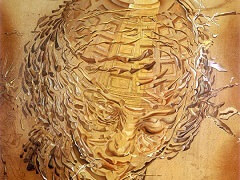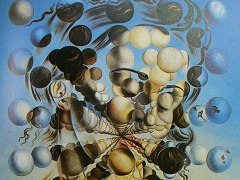The Weaning of Furniture Nutrition, 1934 by Salvador Dali

Dali's second published journal, his Diary of a Genius of 1964, mentions a painting relevant to The Weaning of Furniture Nutrition. The painting he cites is of a Nazy nurse wearing a swastika armband, knitting while seated in a puddle of water. That untitled work caused considerable controversy among the Surrealists, and Dali was forced to paint out the Nazi armband. There is no reference to that work in other documents, and it is possible that it and others such as a work showing Adolf Hitler as a woman, also mentioned in the diary were destroyed during the German occupation of France. The portrait of Hitler no doubt grew out of the artist's fantasies and obsessions of the time. These had to do with a fetishistic attention to items of Hitler's clothing, his uniforms and Sam Browne belt and to the dictator's doughy physique. The date of the two works Dali mentioned is probably 1933 and the figures, as described, are presumably the forerunners of the sitting woman in the foreground of the present work, The Weaning of Furniture Nutrition. The careful emphasis on the back, clothing, and posture of the figure may give some inkling of its controversial and now lost precursors. If that is the case, then the painting is probably the closest surviving example of the sort of works and composition, if not the content, that so displeased the Surrealists, and occasioned Dali's expulsion from the group in 1934, the year of this painting. The painting escaped destruction by the Nazis when its then owner, Jocelyn Walker (Mrs. Charles Potter), fled with it under her arm to London, as the German army invaded the Channel Islands, where she lived. Dali chose the painting as an illustration in his published journal, The Secret Life of Salvador Dali of 1942.
The Weaning of Furniture Nutrition presents the familiar coastal landscape of Dali's childhood (in this case, terraced for planting), together with the Playa S. Morera (with one of the Dali family's two boats and five others) at Port Lligat, close to his own home and studio. In the foreground of this beach scene sits a female figure, based on either Lidia Nogueres or, more probably, Lucia Moncanut, Dali's childhood nurse, shown in an exaggerated scale that emphasizes her importance and prefigures her appearance in many other famous paintings, such as Apparition of Face and Fruit Dish on a Beach of 1938. She sits with her back to the viewer, knitting or perhaps mending a fishing net, with a section of her torso cut out in the shape of the night table that stands next to her, a seemingly bizarre image that may have derived from Dali's recollection of his first trip to Paris, in 1926, and seeing the upper story of the Hotel des Invalides, which, as Dali noted, has windows cut out of human figures. The night table itself is cut out, with the shape of a smaller table and a bottle, in a compositional configuration emulating the influential art of Dali's friend Rene Magritte. The crutch, emblematic both of sexuality and emotional support, which braces the sitting figure, is associated with the nurse's nurturing of the young Dali.























